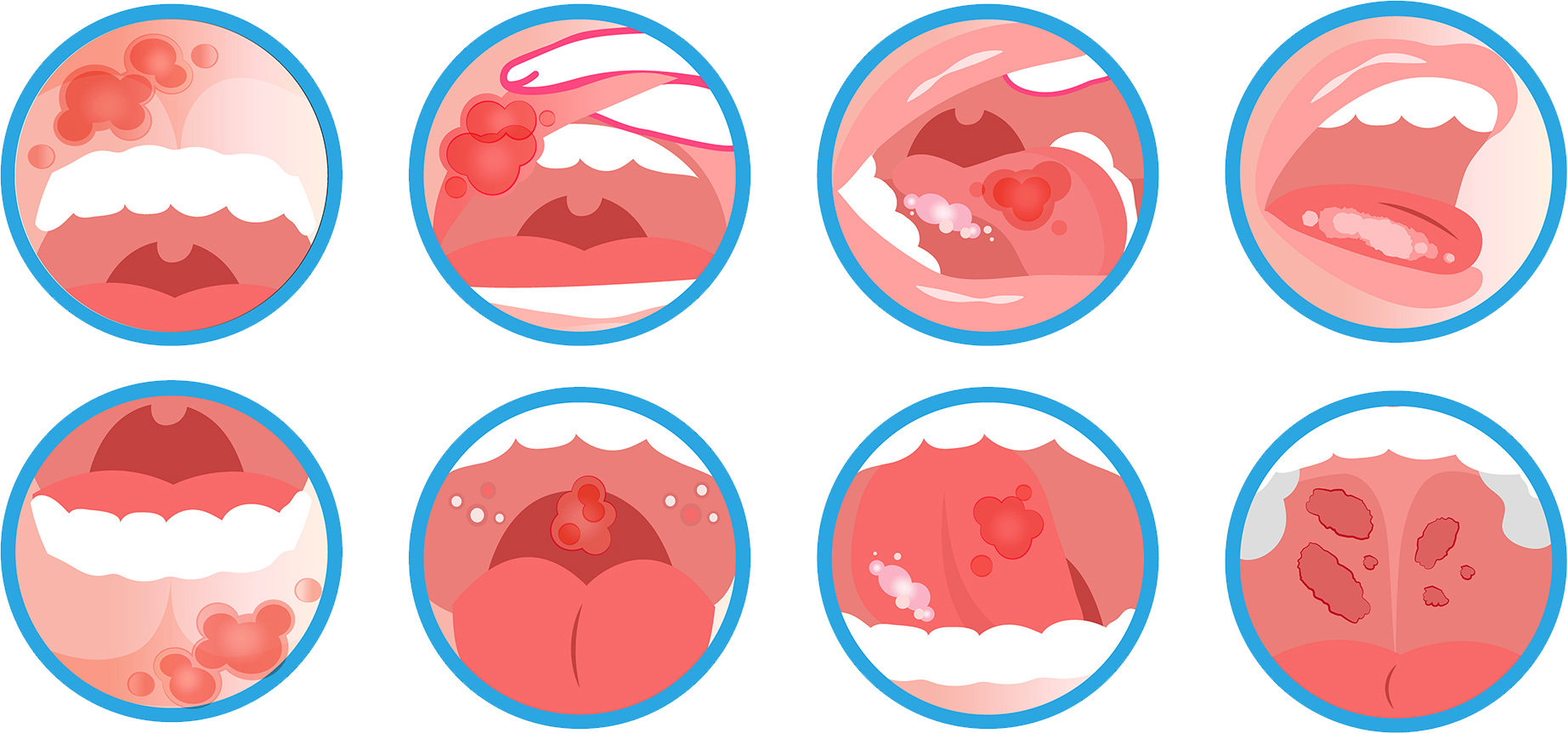
Oral cancer

What is Oral Cancer?
Oral cancer is a type of malignant neoplasm that develops in the tissues of the oral cavity, including the tongue, lips, cheeks, floor and roof of the mouth, gums, and oropharynx. The most common histological type is squamous cell carcinoma. In many cases, oral cancer can spread rapidly to neighboring tissues and lymph nodes, making early diagnosis and treatment crucial for prognosis.

What is Oral Cancer?
Oral cancer is a type of malignant neoplasm that develops in the tissues of the oral cavity, including the tongue, lips, cheeks, floor and roof of the mouth, gums, and oropharynx. The most common histological type is squamous cell carcinoma. In many cases, oral cancer can spread rapidly to neighboring tissues and lymph nodes, making early diagnosis and treatment crucial for prognosis.

What is Oral Cancer?
Oral cancer is a type of malignant neoplasm that develops in the tissues of the oral cavity, including the tongue, lips, cheeks, floor and roof of the mouth, gums, and oropharynx. The most common histological type is squamous cell carcinoma. In many cases, oral cancer can spread rapidly to neighboring tissues and lymph nodes, making early diagnosis and treatment crucial for prognosis.

Risk Factors
The use of tobacco in any form (cigarettes, cigars, chewing tobacco) and excessive alcohol consumption are the two most significant risk factors for the development of oral cancer. The risk increases dramatically when these two factors are combined. Infection with the human papillomavirus (HPV), particularly HPV type 16, has also been recognized as an etiological factor, especially in oropharyngeal cancers. Additionally, prolonged sun exposure can lead to cancer of the lower lip. Chronic trauma to the oral mucosa, poor oral hygiene, and genetic predispositions further increase the risk.

Risk Factors
The use of tobacco in any form (cigarettes, cigars, chewing tobacco) and excessive alcohol consumption are the two most significant risk factors for the development of oral cancer. The risk increases dramatically when these two factors are combined. Infection with the human papillomavirus (HPV), particularly HPV type 16, has also been recognized as an etiological factor, especially in oropharyngeal cancers. Additionally, prolonged sun exposure can lead to cancer of the lower lip. Chronic trauma to the oral mucosa, poor oral hygiene, and genetic predispositions further increase the risk.

Risk Factors
The use of tobacco in any form (cigarettes, cigars, chewing tobacco) and excessive alcohol consumption are the two most significant risk factors for the development of oral cancer. The risk increases dramatically when these two factors are combined. Infection with the human papillomavirus (HPV), particularly HPV type 16, has also been recognized as an etiological factor, especially in oropharyngeal cancers. Additionally, prolonged sun exposure can lead to cancer of the lower lip. Chronic trauma to the oral mucosa, poor oral hygiene, and genetic predispositions further increase the risk.

Symptoms and Clinical Signs
Oral cancer can manifest in various ways, depending on the location and size of the tumor. Commonly observed symptoms include:
- Persistent sores or ulcers that do not heal
- Hard lumps or bumps in the mouth or neck
- White (leukoplakia) or red (erythroplakia) lesions on the mucous membrane
- Pain or difficulty chewing and swallowing
- A feeling of numbness in the mouth or lips
- Difficulty moving the tongue or jaw
- Unexplained tooth loss
- Swelling of the cervical lymph nodes
The presence of any of these symptoms lasting more than two weeks requires immediate medical evaluation.

Symptoms and Clinical Signs
Oral cancer can manifest in various ways, depending on the location and size of the tumor. Commonly observed symptoms include:
- Persistent sores or ulcers that do not heal
- Hard lumps or bumps in the mouth or neck
- White (leukoplakia) or red (erythroplakia) lesions on the mucous membrane
- Pain or difficulty chewing and swallowing
- A feeling of numbness in the mouth or lips
- Difficulty moving the tongue or jaw
- Unexplained tooth loss
- Swelling of the cervical lymph nodes
The presence of any of these symptoms lasting more than two weeks requires immediate medical evaluation.

Symptoms and Clinical Signs
Oral cancer can manifest in various ways, depending on the location and size of the tumor. Commonly observed symptoms include:
- Persistent sores or ulcers that do not heal
- Hard lumps or bumps in the mouth or neck
- White (leukoplakia) or red (erythroplakia) lesions on the mucous membrane
- Pain or difficulty chewing and swallowing
- A feeling of numbness in the mouth or lips
- Difficulty moving the tongue or jaw
- Unexplained tooth loss
- Swelling of the cervical lymph nodes
The presence of any of these symptoms lasting more than two weeks requires immediate medical evaluation.



Diagnosis
Diagnosis is primarily based on clinical examination by a specialized doctor. Any suspicious lesion should be biopsied for histological analysis. Additionally, imaging tests such as CT or MRI scans, ultrasound, and PET-CT are used to map the local or distant spread of the disease. Endoscopic examination can help diagnose cancers of the oropharynx or larynx.

Diagnosis
Diagnosis is primarily based on clinical examination by a specialized doctor. Any suspicious lesion should be biopsied for histological analysis. Additionally, imaging tests such as CT or MRI scans, ultrasound, and PET-CT are used to map the local or distant spread of the disease. Endoscopic examination can help diagnose cancers of the oropharynx or larynx.

Diagnosis
Diagnosis is primarily based on clinical examination by a specialized doctor. Any suspicious lesion should be biopsied for histological analysis. Additionally, imaging tests such as CT or MRI scans, ultrasound, and PET-CT are used to map the local or distant spread of the disease. Endoscopic examination can help diagnose cancers of the oropharynx or larynx.

Therapeutic Approach
The treatment of oral cancer is individualized based on the stage of the disease and the general condition of the patient.
Surgical intervention to remove the primary tumor and affected lymph nodes is usually the first option. In advanced stages, a combination of surgery, radiation therapy, and chemotherapy may be required.
Newer treatments include targeted therapy with molecular inhibitors and immunotherapy, offering new hope for patients with metastatic or recurrent disease.
After treatment, reconstructive surgeries may be needed to improve the aesthetics and functionality of the oral cavity, as well as speech therapy or physical therapy programs.

Therapeutic Approach
The treatment of oral cancer is individualized based on the stage of the disease and the general condition of the patient.
Surgical intervention to remove the primary tumor and affected lymph nodes is usually the first option. In advanced stages, a combination of surgery, radiation therapy, and chemotherapy may be required.
Newer treatments include targeted therapy with molecular inhibitors and immunotherapy, offering new hope for patients with metastatic or recurrent disease.
After treatment, reconstructive surgeries may be needed to improve the aesthetics and functionality of the oral cavity, as well as speech therapy or physical therapy programs.

Therapeutic Approach
The treatment of oral cancer is individualized based on the stage of the disease and the general condition of the patient.
Surgical intervention to remove the primary tumor and affected lymph nodes is usually the first option. In advanced stages, a combination of surgery, radiation therapy, and chemotherapy may be required.
Newer treatments include targeted therapy with molecular inhibitors and immunotherapy, offering new hope for patients with metastatic or recurrent disease.
After treatment, reconstructive surgeries may be needed to improve the aesthetics and functionality of the oral cavity, as well as speech therapy or physical therapy programs.

Prevention
Prevention of oral cancer focuses on avoiding smoking and excessive alcohol consumption, maintaining proper oral hygiene, using sunscreen on the lips, and adopting a healthy diet rich in fruits and vegetables.
Regular check-ups are crucial for the early detection of precancerous or suspicious lesions. Vaccination against HPV offers protection, especially against oropharyngeal cancers associated with the virus.

Prevention
Prevention of oral cancer focuses on avoiding smoking and excessive alcohol consumption, maintaining proper oral hygiene, using sunscreen on the lips, and adopting a healthy diet rich in fruits and vegetables.
Regular check-ups are crucial for the early detection of precancerous or suspicious lesions. Vaccination against HPV offers protection, especially against oropharyngeal cancers associated with the virus.

Prevention
Prevention of oral cancer focuses on avoiding smoking and excessive alcohol consumption, maintaining proper oral hygiene, using sunscreen on the lips, and adopting a healthy diet rich in fruits and vegetables.
Regular check-ups are crucial for the early detection of precancerous or suspicious lesions. Vaccination against HPV offers protection, especially against oropharyngeal cancers associated with the virus.

Conclusion
Oral cancer is a threatening but often preventable disease. Early diagnosis and proper therapeutic management significantly increase survival rates and can preserve the functionality and quality of life of patients. Proper education, prevention, and regular check-ups remain the most powerful tools in combating this disease.

Conclusion
Oral cancer is a threatening but often preventable disease. Early diagnosis and proper therapeutic management significantly increase survival rates and can preserve the functionality and quality of life of patients. Proper education, prevention, and regular check-ups remain the most powerful tools in combating this disease.

Conclusion
Oral cancer is a threatening but often preventable disease. Early diagnosis and proper therapeutic management significantly increase survival rates and can preserve the functionality and quality of life of patients. Proper education, prevention, and regular check-ups remain the most powerful tools in combating this disease.



